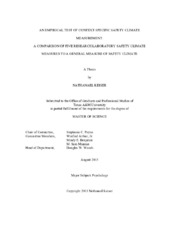| dc.description.abstract | Safety climate researchers include both general and contextualized items in their safety climate measures. However, the relative value of including contextualized items in the prediction of safety outcomes is an empirical question that has not been rigorously tested. Theories about language comprehension and ambiguity indicate that context facilitates meaning. Additionally, memory theories and corresponding empirical research indicates that context facilitates recall. By excluding contextual information, general safety climate measures might provide a comparatively deficient assessment of the underlying construct as indicated by weaker relationships with various safety-related constructs (e.g., safety knowledge, injuries, etc.). In the current study, 757 university laboratory personnel completed a contextualized safety climate measure (i.e., chemical, biological, animal, or human subjects/office research laboratory), a general safety climate measure, and measures of a number of other safety-related constructs. In addition, because some safety climate dimensions appear more conducive to specificity (e.g., safety equipment & housekeeping, co-worker safety practices, and safety training) than others (e.g., management commitment to safety), item level analyses were also conducted. Hypotheses were tested by contrasting the contextualized vs. the general safety climate correlations with various safety outcomes. Only the contextualized human subjects/office laboratory measure was consistently more strongly related to the predictors than the general safety climate measure. The results suggest that contextualized information might facilitate comprehension and recall for individuals who work in less (rather than more) safety-salient contexts. Item-level analyses indicate that contextualization for the rewards safety climate dimension is particularly helpful. The results of this study provide a rigorous test of contextualized measure effectiveness; however, further research is warranted to explicitly test the underlying theory and boundary conditions under which contextual information is beneficial. | en |


